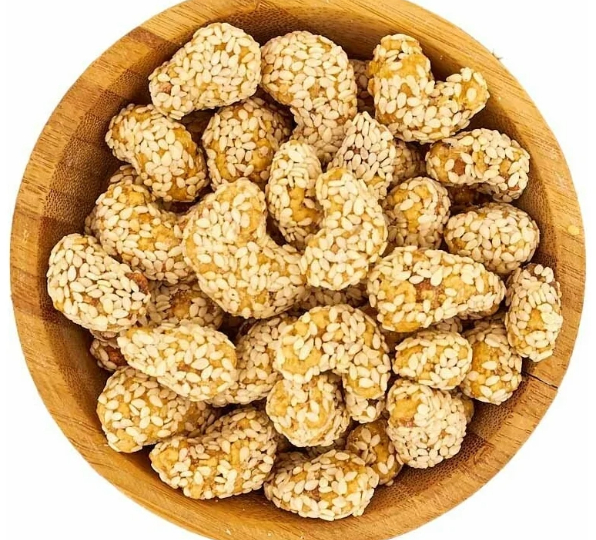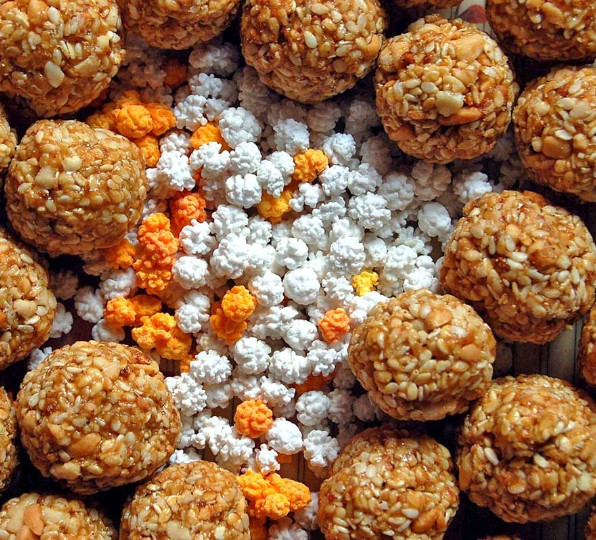Introduction:
The festival of Lohri, which celebrates the end of the winter solstice, is bright and joyous and is mostly observed in Punjab and other parts of North India. Lohri is celebrated with a range of traditional foods that are not only delicious but also nourishing, in addition to bonfires, music, and dance. We’ll look at some of the traditional and healthful food options in this blog that you shouldn’t pass up during the Lohri celebrations.
1. Makki di Roti and Sarson da Saag
Makki di roti and sarson da saag, a beloved traditional dish hailing from the Punjab region of India, epitomize the essence of Lohri festivities with their hearty flavors and rich nutritional profile. This quintessential winter delicacy combines the wholesome goodness of makki di roti, or cornmeal flatbread, with the vibrant flavors of sarson da saag, a curry made from mustard greens. Together, they create a harmonious culinary symphony that delights the senses and nourishes the body.
Sarson da saag, the flavorful curry component of this iconic dish, is a nutritional powerhouse brimming with vitamins, minerals, and antioxidants. Mustard greens, the primary ingredient in sarson da saag, are packed with essential nutrients such as vitamin A, vitamin C, vitamin K, folate, calcium, and iron. These micronutrients play crucial roles in supporting overall health and well-being, from bolstering immune function to promoting bone health and combating oxidative stress.
In addition to its nutritional bounty, sarson da saag offers a burst of vibrant flavors, ranging from earthy and slightly bitter notes to subtle hints of spiciness and sweetness. The complex interplay of spices and aromatics, such as ginger, garlic, green chilies, and garam masala, adds depth and complexity to the curry, elevating it from a simple vegetable dish to a culinary masterpiece.
Complementing the nutrient-rich sarson da saag is makki di roti, a rustic flatbread made from cornmeal. Makki di roti provides a hearty foundation for the dish, offering complex carbohydrates, dietary fiber, and a unique texture that perfectly complements the robust flavors of the curry. The coarse texture of cornmeal lends a satisfying crunch to the roti, while its natural sweetness adds a delightful contrast to the savory curry.
Together, makki di roti and sarson da saag form a balanced and satisfying meal that nourishes both body and soul. This cherished winter delicacy not only celebrates the rich culinary heritage of the Punjab region but also exemplifies the spirit of warmth, abundance, and togetherness synonymous with Lohri festivities. Whether enjoyed with family and friends around a bonfire or savored in the comfort of home, makki di roti and sarson da saag are sure to evoke feelings of joy, gratitude, and culinary delight.
2. Til (Sesame) and Gur (Jaggery) Delicacies
Til (sesame) and gur (jaggery) delicacies hold a special place in the heart of Lohri celebrations, enriching the festivities with their delightful flavors and nutritional goodness. These traditional ingredients form the backbone of various sweets and snacks prepared during Lohri, including til ladoo, gur ki patti, and til chikki. Beyond their delectable taste, these treats are prized for their rich nutrient content, offering a healthier alternative to refined sugar-based desserts.
Sesame seeds, or til, are revered for their nutritional potency and culinary versatility. Packed with essential nutrients like iron, calcium, magnesium, phosphorus, and zinc, sesame seeds impart a wealth of health benefits to Lohri delicacies. Iron, crucial for oxygen transport in the body, supports energy metabolism and prevents anemia, while calcium strengthens bones and teeth, promoting overall bone health. Additionally, sesame seeds are rich in antioxidants, including lignans and vitamin E, which help combat oxidative stress and inflammation, reducing the risk of chronic diseases.
Complementing the nutritional bounty of sesame seeds is gur, or jaggery, a traditional sweetener derived from sugarcane juice or palm sap. Unlike refined sugar, which undergoes extensive processing and stripping of nutrients, gur retains its natural vitamins and minerals, including iron, calcium, and potassium. Iron-rich gur helps prevent iron deficiency anemia and promotes healthy blood circulation, while calcium supports bone health and muscle function. Moreover, the presence of potassium in gur helps regulate blood pressure and electrolyte balance, supporting heart health and hydration.
Together, til and gur create a harmonious fusion of flavors and nutrients that make Lohri sweets and snacks not only delicious but also nourishing for the body and soul. Whether enjoyed as crunchy til chikki, chewy gur ki patti, or aromatic til ladoo, these treats offer a guilt-free indulgence that celebrates the richness of tradition and the bounty of nature.
3. Gajak and Rewri
Gajak and rewri, two beloved sweets synonymous with the Lohri festivities, encapsulate the essence of tradition and culinary excellence with their rich flavors and nutritional benefits. Crafted from simple yet wholesome ingredients such as sesame seeds, jaggery, and occasionally nuts like peanuts or almonds, these crunchy delights have been cherished for generations for their irresistible taste and nourishing properties.
Sesame seeds, the star ingredient in gajak and rewri, are nutritional powerhouses packed with a plethora of essential nutrients. These tiny seeds are rich in iron, calcium, magnesium, zinc, and antioxidants, making them a valuable addition to any diet. Iron is crucial for oxygen transport in the body and plays a vital role in preventing anemia, while calcium supports bone health and helps maintain strong teeth. Additionally, magnesium contributes to muscle and nerve function, while zinc supports immune function and wound healing.
Jaggery, a traditional sweetener derived from sugarcane or palm sap, adds sweetness and depth to gajak and rewri while providing additional health benefits. Unlike refined sugar, which undergoes extensive processing and stripping of nutrients, jaggery retains its natural vitamins and minerals, including iron, potassium, and antioxidants. This makes jaggery a healthier alternative to refined sugar-based desserts, offering sweetness with added nutritional value.
Furthermore, gajak and rewri often incorporate nuts such as peanuts or almonds, which contribute protein, healthy fats, and additional vitamins and minerals to these delectable treats. Peanuts are a good source of protein and heart-healthy fats, while almonds provide vitamin E, an antioxidant that helps protect cells from damage caused by free radicals.
4. Moongphali (Peanuts)
Peanuts, or moongphali, hold a special place in the festivities of Lohri, where they are celebrated not only for their crunchy texture and nutty flavor but also for their abundant nutritional benefits. As a staple snack during these celebrations, roasted peanuts are enjoyed both on their own and as a versatile ingredient in various dishes, adding depth and richness to traditional recipes.
One of the most notable qualities of peanuts is their impressive nutritional profile. These humble legumes are rich in protein, making them an excellent plant-based source of this essential nutrient. Protein is crucial for building and repairing tissues, supporting muscle growth, and maintaining overall health and vitality. Including peanuts in the Lohri spread ensures that celebrants have access to a satiating and protein-rich snack that can help keep hunger at bay and provide sustained energy throughout the festivities.
In addition to protein, peanuts are also abundant in healthy fats, including monounsaturated and polyunsaturated fats. These heart-healthy fats have been associated with numerous health benefits, including reduced risk of heart disease, improved cholesterol levels, and better blood sugar control. By incorporating peanuts into their Lohri celebrations, individuals can indulge in a satisfying snack that not only satisfies their taste buds but also supports their cardiovascular health and overall well-being.
Furthermore, peanuts are packed with essential vitamins and minerals, including vitamin E, niacin, folate, magnesium, and phosphorus. Vitamin E is a powerful antioxidant that helps protect cells from damage caused by free radicals, while niacin and folate are important for energy metabolism and nervous system function. Magnesium and phosphorus play crucial roles in bone health, muscle function, and energy production, ensuring that the body remains strong and energized during the festivities.
5. Kheer and Rice Pulao
During the joyous celebrations of Lohri, two quintessential rice-based dishes take center stage, offering a delectable fusion of flavors and textures that symbolize the richness of the festive season. Kheer, a luscious rice pudding, and rice pulao, a savory rice dish, epitomize the culinary diversity and cultural heritage of the occasion, delighting taste buds with their sweet and savory profiles.
Kheer, a beloved dessert synonymous with festive occasions across India, holds a place of honor during Lohri celebrations. This creamy and indulgent rice pudding is crafted from simple yet wholesome ingredients, including rice, milk, sugar, and a medley of aromatic spices and nuts. Traditionally, kheer is flavored with fragrant cardamom and saffron, which impart a heavenly aroma and subtle sweetness to the dish. Nuts such as almonds, cashews, and pistachios add crunch and richness, elevating the kheer to a luxurious treat fit for special occasions like Lohri. Whether served warm or chilled, kheer delights palates with its velvety texture and irresistible combination of flavors, evoking feelings of warmth, comfort, and indulgence.
In contrast to the sweet indulgence of kheer, rice pulao offers a savory counterpart that balances the festive feast with its aromatic spices and vibrant flavors. This fragrant rice dish, also known as pulao or pilaf, is prepared by cooking rice with an assortment of vegetables, spices, and aromatic herbs. Common ingredients used in rice pulao include onions, carrots, peas, bell peppers, and tomatoes, which lend color, texture, and nutritional value to the dish. Aromatic spices such as cumin, cloves, cinnamon, and bay leaves infuse the pulao with layers of flavor, while fresh herbs like cilantro and mint add brightness and freshness to each bite. The result is a tantalizing medley of sweet, savory, and aromatic notes that tantalize the taste buds and elevate the festive feast to new heights.


Conclusion:
Lohri is not only a time for celebration and bonhomie but also an occasion to indulge in traditional and healthy foods that are an integral part of the festivities. From wholesome meals like makki di roti and sarson da saag to nutritious snacks like til and gur delicacies, Lohri offers a plethora of options to savor and enjoy. Embrace the spirit of the festival by relishing these traditional and healthy food options with your loved ones and spreading joy and warmth during the winter celebrations.












